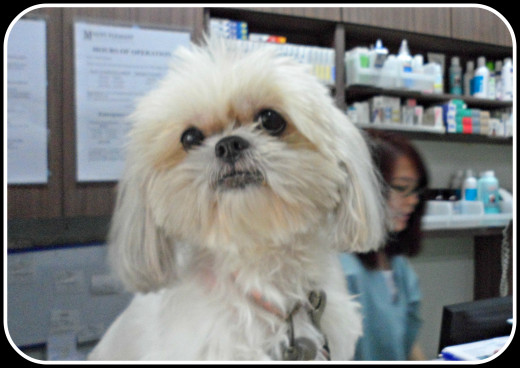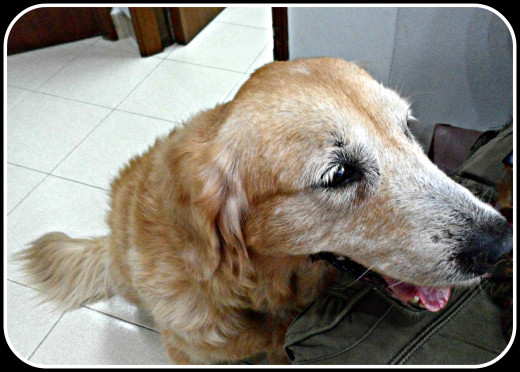Making the trip to the veterinarian easier for yourself, your pet and the vet
By Michelle Liew


When to bring your dog to the vet
A trip to the veterinarian can be an overwhelming experience for yourself and your pet. Some owners meet with defiant resistance when it comes time to make the trip.
Like trips to the doctors for us, visits to the vet can be traumatic occasions for your pet, which may seem to want to do anything and everything to get out of one. Besides causing a knee jerk yowl or wriggle of discomfort on FiFi or Fido’s part, it brings problems to pet owners.
So why do our pets dislike the vet’s so much and what problems will new owners potentially face on their first trip to the vet?


Why pets dislike visits to the veterinarian
In the same way as many of us hate going to the doctors, our pets’ peeves are the vets. New owners especially might wonder why their dogs put up so much resistance when their dogs are being brought to the veterinarian's, so here are some of the reasons for their discomfort.
Unfamiliar surroundings
Your pet faces unfamiliar surroundings when it goes to the veterinarian’s. A young pet which has never been to the veterinarian’s before might display signs of insecurity when it is brought to a new place like the vet’s, with unfamiliar sights, smells and potentially frightening medical procedures like injections.
This applies to older dogs too. My older dog, Misty, experienced this exact discomfort when I took her to the vet’s, which recently moved to a new location and building. Reflecting her fright, she pooped on the floor, to the chagrin of the others around.
Being in carriers
For many animals, a trip to the veterinarian means being enclosed in a carrier for some period of time.
For my young dog, Cloudy, me pulling the carrier down from its shelf in the storeroom means that she has to take a trip to somewhere she does not like, and it is usually to see the vet. You find her disappearing when it happens!
Negative experiences
Pets who have had negative experiences at the vets like the sting of an injection might try to escape from such trips when they can.
Cloudy, a hater of injections, put up a lot of resistance when I tried to bring her into the veterinarian’s clinic. She would not go through the door. Then I found that she associated it with injections and medicine - two of her pet peeves! Hence, I had to find a way to make her trip (and hence mine) easier.


What problems might owners face when bringing their dogs to the vet?
Indeed, owners might face a few difficulties when bringing their pets to the vet. And they are not just related to a little resistance, though that is certainly one of them.
There is the difficulty of finding transport.
If one has a car, it is definitely not an issue. This pertains more to those who rely on public transportation.
Not all taxis will take passengers with animals in tow. I usually have to bring my dog to the vet in a taxi, so I sometimes find it difficult to get the support of cabbies who might find the smell of my dog offensive (dogs tend to have their “dog odor”) be afraid of pets shedding on seats or worse still, pooping on the mats.
I usually give the cab company a call before bringing my dog to the vet and let them know that I will need a cab, having a small dog in tow. The company usually helps me locate cabbies that are willing to take on passengers with dogs.
Ah...the beauty of carriers!
As I have mentioned, some animals, especially those not introduced to carriers tend to dislike being enclosed as much as we do. Unfortunately, a trip to the vet would require just this for the pet’s safety or because cabs will not take an animal not in a carrier.
The carrier would mean two things-restriction and a trip to the vets! It certainly does from my dogs, who understandably put up a little resistance when being put in them.
Time
Taking a pet to the vet would require time on the owners’ part, and with a busy schedule at work or home, that can pose a difficulty. Such a problem, though, can be worked around with a little effort!
Another consideration viz time is that some veterinarians might not offer 24 hour care when an animal is in distress. When my dog, Misty, had a seizure, the clinic nearby did not offer 24 hour care and I had to bring her to another hospital.
Distance
The nearest veterinarian might be some distance away, and this would mean a long ride, especially when a pet is really sick.
When first moving into a new area with your pet, it is always good to check it for nearby vets.
Finance
Bringing a pet to the vet will incur many costs, some of them more expensive that our own trips to doctors.
Weighing financial considerations before committing to a pet would be better than finding out about the costs that will be incurred and later abandoning it.


When would my pet need immediate veterinary attention?
There are times, of course, when a trip to the vet is imperative. Here are examples of when it is necessary to take your pet for a visit.
Trauma
If your pet has sustained trauma from a fight, fall, wounds or accidents, it warrants immediate veterinary attention and there is no time to put it off. Head for the nearest vet that offers 24 hour care.
The dog has difficulty breathing
A dog or cat might suffer from dysprena or difficulty breathing. This shows itself in the form of wheezing, coughing or weak and raspy breathing that can lead to respiratory arrest.
This can be caused by a foreign body in the throat, pulmonary problems, an allergic reaction or heart disease. If you determine that a foreign body is lodged within the throat, do not attempt to take it out yourself. Bring it immediately to the vet for removal, for it would be lodged deeper if you try to extract it on your own.
Seizures
Seizures are surprisingly common occurrences in dogs. They can be caused by neurological problems but deserve their own heading. Signs include shaking, tremors and loss of consciousness. The most common cause of it is epilepsy.
Not every seizure is a medical emergency. If the dog just collapses for a while and gets back on track, there is no need to hurry off to the vet, but good to schedule an appointment as soon as possible.
Misty had a seizure when she collapsed in the toilet. She was rushed to emergency veterinary care at 4 a.m. in the morning, but the cause of her seizure is still pending further tests.
Dog vomiting and diarrhea
Vomiting and diarrhea can be signs of serious health issues, but many are the result of simple gastric upsets. Make sure that your dog has lots of water and if the diarrhea continues after more than a day, take your dog to the vet immediately.
A distended abdomen
If your dog has a distended or bloated tummy and seems to be in pain then a problem requiring medical attention is likely. It can be accompanied by retching, heaves, weakness, collapse and difficulty breathing. Bloat usually occurs in larger breeds of dogs.
The sooner it can be taken to the vet, the better the chances for a positive outcome.
Ocular problems
Eye problems in dogs tend to worsen faster than problems in other areas. They can result in blindness if not treated, especially glaucoma. SIgns include excessive tearing, swelling, squinting and pawing at the eye.
Dog urinary problems
If you notice your pet not producing urine see your vet as soon as possible. Urinary blockages can be life threatening and warrant immediate veterinary attention.
Dog whelping emergencies
If your dog goes into labor and you notice that more than four hours pass without puppies and more than 30 minutes elapse without puppies then she could be experiencing dystocia. Consult your vet for further advice.


How to make trips to the vet easier
So there are times when a trip to a vet's is necessary. So when are they?
Have a positive attitude.
If you reflect that a trip to the vet is negative or troublesome, your pet picks up on your mood and will likely dislike it too. So try to put on an assuring, happy face.
The dreaded car trip
On occasion, an owner might find it hard to put their pets in cars. If your pet has only been in a car that results in an injection some other painful procedure, he cannot be blamed for disliking travel. Mix it up and take him on other road trips that end enjoyably. Then he will be less resistant to the car ride!
Make carriers comfortable.
To overcome carrier resistance, make them part of the household furniture and keep the door open. Leave treats in it. On occasion, your pet might be drawn to it for a nap and will associate it with something positive.
Scents
Synthetic pheromones mimic the smells animals create to calm themselves. This can be sprayed in the carrier or the car before a trip to the vet to create some form of comfort and familiarity. It will make the carrier more cosy.
Crutches!
No, I am not talking about the walking sort, but the chemical crutch of anxiety medication.This is to be used only if your pet really needs it and there is no other alternative. Some pets are really anxious and need more help than we can provide. Consult a vet to ask for appropriate medicine for your next visit. Be careful to ask about any possible side effects of the medication, which would warrant looking for another solution for bringing your pet to the vet.

Conclusion
A trip to the vet, with a little help, need not be a horrifying experience. Try making it easier for yourself, your pet and of course, the vet.
A special thank you to the writers who answered the question “Do you have challenges bringing your dog to the vet, and if you have, what are they?” There were insightful comments, so do check each of them out.

- How to communicate with your dog and interpret the m...
On how your canine communicates through its eyes, ears and facial expressions. We should also be careful of the messages we are sending our dogs! - Things to consider when adopting a dog:rescuing dogs...
An article on the things to consider when adopting a dog. - The challenges of looking after a senior dog with a ...
What are some of the signs that your dog is now a senior pet? What are the conditions that may strike? And what happens if it also has a neurological disorder? - Causes of skin disorder in dogs:symptoms, types and ...
What are the symptoms, causes and types of skin diseases in dogs? Which breeds usually experience them? - Warning signs of neurological disorders in canines -...
How do you know if your dog has a neurological disorder? This article aims to help owners spot signs of neurological problems in dogs, coming from the author's own experience. What are the neurological disorders that bother dogs? - Ten rare canines to consider as family pets
Here are 10 rare breeds of canines to consider as pets! - How to determine if a dog has been poisoned:causes, ...
An article on the causes, symptoms and prevention of poisoning in dogs.

This article is accurate and true to the best of the author’s knowledge. It is not meant to substitute for diagnosis, prognosis, treatment, prescription, or formal and individualized advice from a veterinary medical professional. Animals exhibiting signs and symptoms of distress should be seen by a veterinarian immediately.



